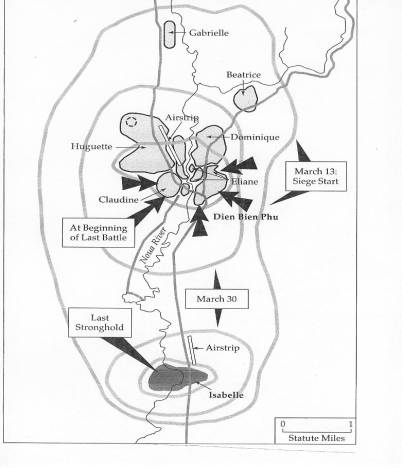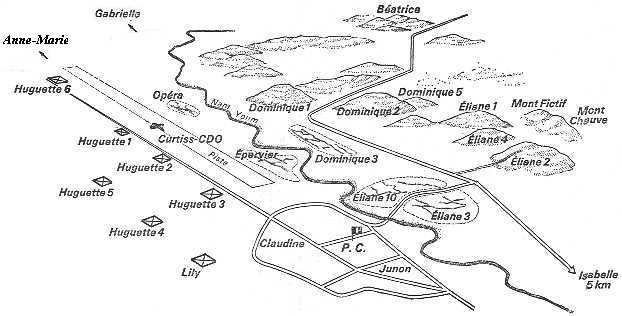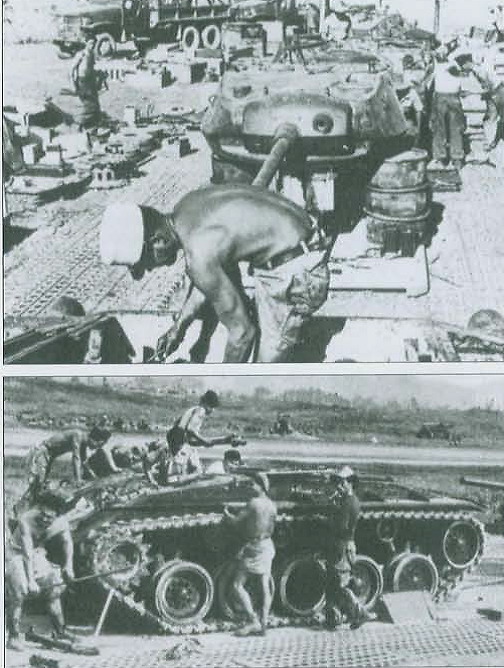Hello everyone,
about two months ago, I published a shorter post about the M24 Chaffee at Dien Bien Phu by CounterMAN. The article didn’t focus that much on the battle as it did on the vehicle itself, but today, we are going to have a look at the Dien Bien Phu a bit closer.
Dien Bien Phu is probably the best known battle in the series of post-WW2 wars, that marked the dissolution of the former colonial empires of France and Britain. For France, it was the decisive turning point of the entire conflict in Indochina, from which, despite the fighting going on, the French far east army was never able to recover. Amongst those who battled and fell at Dien Bien Phu were the crews of several M24 Chaffee tanks, often fighting against tremendous odds.
Dien Bien Phu was intended to be a decisive battle between the French and the Viet Minh organization – at that point practically a real army with all its strength and drawbacks. Strategically – at least the French thought this way, Dien Bien Phu was to be a strongpoing, a base of operations, from which the French units would attack the Vietnamese forces in north-western Vietnam, forcing them to withdraw from the Tonkin front and from neighboring Laos. The base was designed as very powerful, it even had its own artillery detachment and an airstrip, inteded for the F8F Bearcats of GC I/22.
In order to improve the offensive capabilities of the units stationed here, an escadron of M24 Chaffee tanks from the 1st Cavalry Regiment (1er Régiment de Chasseurs á Cheval) was transferred here as well. Transporting them to the base however proved to be quite an undertaking and a serious issue. Dien Bien Phu was located 350km from Hanoi and could be supplied only by air. The French Air Force was operating the C-47 Skytrain and C-119 Packet, piloted by American volunteers – both relatively small aircraft, capable of transporting trucks, 105mm howitzers and men, but the 18 ton Chaffee was too heavy for them to carry. That’s why it was necessery to actually dismantle the tanks and transport them in pieces.
Assembling the Chaffees at Dien Bien Phu
The tanks, transferred to Dien Bien Phu, were dismantled at the Gia Lam base in Hanoi by the men of the 2nd Armor Repair Company of the Foreign Legion (2e Compagnie de Reparations d’Engines Blindés Legion Etrangére), who managed to separate them into 180 pieces. In order to transport the largest pieces, the French had to borrow Bristol 170 Freighter planes from Air Vietnam – these were the largest planes, capable of landing at Dien Bien Phu. In the end however, it turned out that even so, the hull of the Chaffee was 150kg heavier than what the Freighter could carry – in order to actually fly over the mountains in the Tonkin region, the plane was stripped of all the unnecessary parts. They made it, but just barely. The operation to transfer the tanks was called Rondelle II and begun on 16.12.1953. In order to get the tanks going as fast as possible, the men of the 2nd ARCFL (reinforced by specialists from 1er Battalion de Réparations du Materiél from Saigon) did set up their shop straight at the Dien Bien Phu air strip. Two days later, first two tanks landed – albeit disassembled – on the Dien Bien Phu strip and their assembly was initiated immediately. Transporting the tanks took until the end of December 1953, for each tank, 2 Freighter trips and 6 C-47 trips were needed.
First two tanks were assembled on Christmas day, 24.12.1953 and immediately, first platoon was formed from them. The rest of the tanks were assembled until 15.1.1954 and five days later, they were officially designated as a unit by the name of “Escadron de Marche de 1er Régiment de Chasseurs á Cheval” (something like “1st Cavalry Regiment Escadron”), commanded by 24 year old captain Yves Hervouët, a brave officers, awarded by Legion of Honour (one of the highest French awards). The Escadron consisted of 10 tanks, split into three platoons (three tanks each) and one command vehicle.
Two platoons, one commanded by Cpl.Carette, the other by Sgt.Guntz, were positioned in the center of the defense, while the third one, under Lt.Henri Préaud, was positioned at checkpoint Isabelle, 3,5km south from the main base. According to the French traditions, all the tanks were named after famous battles and commanders (the soldiers at Dien Bien Phu were calling the tanks “bisons”, the Vietnamese were calling them “oxen”). The tanks were named as such:
- command tank: Conti
- Carette’s platoon: Mulhouse, Bazeilles, Douamont
- Guntz’s platoon: Smolensk, Posen, Ettlingen
- Préaud’s platoon: Auerstaedt, Neumach, Ratisbonne
The tanks were sent to action immediately. Using the morning fog, they started scouting the outskirts of the base, acquainting themselves with the terrain.
The first clash with the enemy happened on 1.2.1954 near the Gabrielle position. Following this incident, the task of the tanks was to conduct sorties into neighboring hills, looking for and destroying the positions of Vietnamese artillery, which was more and more harassing the French positions. The conflict was slowly escalating, until, after only a few months of preparations, the battle of Dien Bien Phu finally started on 13.3.1954 in earnest.
At 17:00, the entire basin exploded with fire, as dozens of Vietnamese guns started firing at the French, focusing their attention on the Beatrice positions on the north-eastern edge of the basin. The position was then attacked by the 312th Vietnamese Division and fell after several hours of tenacious fighting. Of 550 legionnaires, only few dozen men survived, relieved by the counterattack of tanks and paratroopers in the morning of 14.3.1953. Right after the noon of 14.3., position Gabrielled became the next target of attack from the north. The scenario was the same – the position was shelled, followed by an infantry attack of thousands of Vietnamese troops. The fighting went on through the night and in order not to repeat the situation from the previous day, a strong counterattack was prepared, consisting of 6 tanks and two paratrooper batallions (1st Foreign Legion Batallion and 5th Vietnamese Batallion). The counterattack started at 5:30AM on 15.3., but after initial advances, it was stopped near the village of Ban Khe Phai, roughly one kilometer from Gabrielle. At that point, the Vietnamese threw in the entire 308th division (12 thousand men) and after few more hours of fighting, the defenders of Gabrielle started to retreat. Protected by tanks, which carried many wounded men on their hulls, the sector was abandoned by 4 remaining officers and 150 men, belonging to Algiers Rifles. During the fighting, Sgt.Guntz, one of the Chaffee platoon commanders, fell and the platoon was commanded from that point on by Cpl.Ney.
Third target of an attack became the Anne-Marie position, defended by Thai soldiers. The fighting was extremely brutal and before the position was abandoned, thousands of dead and wounded Vietnamese soldiers were lying in the mud. These appalling losses gave Vietnamese commander, General Giap a pause for a while – he temporarily limited his combat operations to shelling the defense with his artillery, digging his own trenches and occassionally a limited attack. However, the southern Isabelle sector was practically cut off from the main French positions.
Auerstaedt, Henri Préaud’s tank
The French tried attacking as well and most of these attempts involved the tanks of Capt.Hervouët. The fact that each tank could carry only limited amount of ammo for the main gun (48 rounds) turned out to be a serious problem, because the battle ammo consumption was enormous. This led to the attempts to store additional rounds wherever possible, including the floor of the combat compartment, around driver’s station, tying them to mudguards and on the engine lid. Another idea was to use one of platoon’s tanks strictly to carry ammunition, but this limited the platoon’s firepower. Whenever the Chaffees were not used for these sorties, they were used as strongpoints and mobile pillboxes at positions where the crews and fuel were positioned as well. Vietnamese artillery however did cause some losses: on 29.5.1954, Douamount was hit by a 105mm shell, damaging the tank and killing three of the crewmembers. Ratisbonne was hit twice the very same day as well, but the explosions did not cause any serious damage to the tank.
To be continued…
Source:
pavel70slama.blog.cz/1312/tanky-m-24-chaffee-v-dien-bien-phu
www.valka.cz
various threads on forums





(y)
Good read. Very interesting how they actually got the tanks there
I looked at the length of the article and had my doubts, but forged ahead.
Quite interesting to read, thanks.
Excellent! Very interesting read, love the details!
More, please!
In case you wonder about the german names of the tanks: it was the so called “last battle of the Waffen SS”!
German article about this battle: http://www.welt.de/geschichte/article127710149/Dien-Bien-Phu-die-letzte-Schlacht-der-Waffen-SS.html
Pingback: Chaffees at Dien Bien Phu – Part II | For The Record